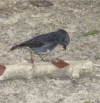Memory for multiple cache locations and prey quantities in a food-hoarding songbird
- PMID: 23293622
- PMCID: PMC3533374
- DOI: 10.3389/fpsyg.2012.00584
Memory for multiple cache locations and prey quantities in a food-hoarding songbird
Abstract
Most animals can discriminate between pairs of numbers that are each less than four without training. However, North Island robins (Petroica longipes), a food-hoarding songbird endemic to New Zealand, can discriminate between quantities of items as high as eight without training. Here we investigate whether robins are capable of other complex quantity discrimination tasks. We test whether their ability to discriminate between small quantities declines with (1) the number of cache sites containing prey rewards and (2) the length of time separating cache creation and retrieval (retention interval). Results showed that subjects generally performed above-chance expectations. They were equally able to discriminate between different combinations of prey quantities that were hidden from view in 2, 3, and 4 cache sites from between 1, 10, and 60 s. Overall results indicate that North Island robins can process complex quantity information involving more than two discrete quantities of items for up to 1 min long retention intervals without training.
Keywords: New Zealand robin; cache; field experiment; memory; number.
Figures


References
-
- Alexander L., Duthie C., Fyfe J., Haws Z., Hunt S., Montoya I., et al. (2005). An experimental evaluation of food hoarding by North Island robins (Petroica australis longipes). Notornis 52, 138–142
-
- Andersson M., Krebs J. (1978). On the evolution of hoarding behaviour. Anim. Behav. 26, 707–71110.1016/0003-3472(78)90137-9 - DOI
-
- Ardern S. L., Ma W., Ewen J. G., Armstrong D. P. (1997). Social and sexual monogamy in translocated New Zealand robin populations detected using minisatellite DNA. The Auk 114, 120–12610.2307/4089074 - DOI
-
- Armstrong D. P., Ewen J. G., Dimond W. J., Lovegrove T. G. (2000). Breeding biology of North Island robins (Petroica australis longipes) on Tiritiri Matangi Island, Hauraki Gulf, New Zealand. Notornis 47, 106–118
-
- Baker M. C., Stone E., Baker A. E. M., Shelden R. J., Skillicorn P., Mantych M. D. (1988). Evidence against observational-learning in storage and recovery of seeds by black-capped chickadees. Auk 105, 492–497
LinkOut - more resources
Full Text Sources

